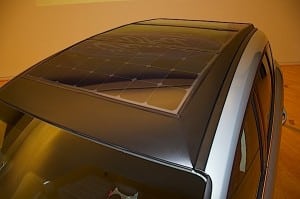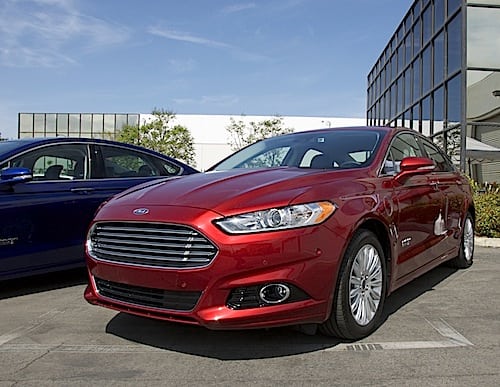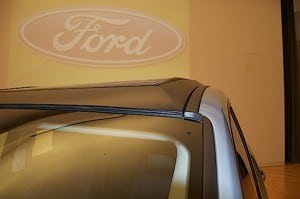 The following article has been updated with a Ford Press Release below.
The following article has been updated with a Ford Press Release below.
CarNewsCafe met with Mike Tinskey, Global Director of Vehicle Electrification and Infrastructure at Ford about the C-MAX Solar Energi Concept, we covered here.
The growing energy consumption worldwide
The average American household consumes today about 25 times more energy than it did in 1930. If a home consumed around 500 kWh a year in 1930, today it averages 12,000. To put things into context, electricity was 8 cents a kWh, the equivalent of a $1 today, and gasoline was 10 cents a gallon. Today, gasoline is 4 times as much.
Ford’s calculates transportation energy over 80 miles with 40 mpg car that will cost around $4 worth of gasoline. By comparison, the Nissan LEAF costs 11 cents per kWh for the same distance, and the Ford Focus Electric 5 cents per kWh. However, using solar panels with a Ford Focus Electric, you are paying nothing, and that’s why Ford partnered with SunPower and their Drive For Life program.
Considering solar energy cost has fallen by as much as 60% since 2009 and that the efficiency of solar panels now hovers around 18%, SunPower’s S21 panels, the ones on the C-MAX Solar Energi Concept, offer 21%. Those same panels can give about an 8th of the charge. Those panels are curved to match the roof line and add little weight to the car.
So how do you increase the performance and efficiency in this case? Ford turned to Georgia’s university to see what more could be done. The school devised of a carport with panels on top and a lens to concentrates sunlight. The C-MAX Solar Energi Concept is connected to the cloud and Ford’s servers tell it to place itself under the carport solar panels for maximum efficiency.
What does it mean for consumers?
The concept would be very practical if it was available now. Electric vehicles’ (EV) drivetrain are notoriously efficient at around 96% to 98 compared to gasoline engines. They also excel in congested areas where idling means more energy saved, against compared to the opposite for gasoline engines. If we were to drive the C-MAX Solar Energi Concept in a congested highway, it would recharge the battery through the SunPower solar panels and add a few miles while sitting in traffic. Unfortunately, the concept is not ready yet for prime time yet, but we believe it will be in a few years. As solar panels raise efficiency the next few years, and photovoltaic paint is used on automobiles, the C-MAX Solar Energi Concept should become a reality.
How long to charge on solar?
Based on South Carolina’s Charleston city, which was chosen for its average irradiance of sunshine, the C-MAX Energi Solar Concept takes six to seven hours to charge. Those numbers improve by 50% in a city such as Los Angeles.
While Ford is careful to call its C-MAX Energi Solar Concept a concept, the idea has merit since photovoltaic technology will continue to play an even greater role in transportation. With the fast breakthroughs in this industry, solar panels on cars will become common. We are very excited about the concept and look forward to see how it will develop over the next few years.
Press Release:
Let the Sun In: Ford C-MAX Solar Energi Concept Goes Off the Grid, Gives Glimpse of Clean Vehicle Future
- Ford C-MAX Solar Energi Concept is first-of-its-kind sun-powered vehicle with the potential to deliver the best of a plug-in hybrid without depending on the electric grid for fuel
- C-MAX Solar Energi Concept with a solar panel roof draws power from a special solar concentrator lens similar to a magnifying glass
- By using renewable power, Ford C-MAX Solar Energi Concept is estimated to reduce the annual greenhouse gas emissions a typical owner would produce by four metric tons
- C-MAX Solar Energi Concept, which will be on display at the 2014 International CES in Las Vegas, Jan. 7-10, debuts as Ford’s strong electrified vehicle lineup is expected to post a record 85,000-plus sales for 2013
Ford Motor Company announced today the C-MAX Solar Energi Concept, a first-of-its-kind sun-powered vehicle with the potential to deliver the best of what a plug-in hybrid offers – without depending on the electric grid for fuel.
Instead of powering its battery from an electrical outlet, Ford C-MAX Solar Energi Concept harnesses the power of the sun by using a special concentrator that acts like a magnifying glass, directing intense rays to solar panels on the vehicle roof.
The result is a concept vehicle that takes a day’s worth of sunlight to deliver the same performance as the conventional C-MAX Energi plug-in hybrid, which draws its power from the electric grid. Ford C-MAX Energi gets a combined best miles per gallon equivalent in its class, with EPA-estimated 108 MPGe city and 92 MPGe highway, for a combined 100 MPGe. By using renewable power, Ford C-MAX Solar Energi Concept is estimated to reduce the annual greenhouse gas emissions a typical owner would produce by four metric tons.
“Ford C-MAX Solar Energi Concept shines a new light on electric transportation and renewable energy,” said Mike Tinskey, Ford global director of vehicle electrification and infrastructure. “As an innovation leader, we want to further the public dialog about the art of the possible in moving the world toward a cleaner future.”
C-MAX Solar Energi Concept, which will be shown at the 2014 International CES in Las Vegas, is a collaborative project of Ford, San Jose, Calif.-based SunPower Corp. and Atlanta-based Georgia Institute of Technology.
Strong electrified vehicle sales
The C-MAX Solar Energi Concept debuts as Ford caps a record year of electrified vehicle sales.
Ford expects to sell 85,000 hybrids, plug-in hybrids and all-electric vehicles for 2013 – the first full year its six new electrified vehicles were available in dealer showrooms.
C-MAX Energi is Ford’s plug-in sales leader, with sales of more than 6,300 through November. Ford sold more plug-in vehicles in October and November than both Toyota and Tesla, and it outsold Toyota through the first 11 months of 2013. Plug-in hybrids continue to grow in sales as more customers discover the benefits of using electricity to extend their driving range.
C-MAX Hybrid over the last year has been a key driver in helping Ford sell more hybrids than any other automaker in the United States, second only to Toyota. C-MAX Hybrid continues to bring new customers to the Ford brand, with a conquest rate of 64 percent and drawing nearly half of its sales from import brands. Conquest rates are even higher in key hybrid growth markets like San Francisco, Los Angeles and Washington, D.C.
Breakthrough clean technology
SunPower, which has been Ford’s solar technology partner since 2011, is providing high-efficiency solar cells for the roof of Ford C-MAX Solar Energi Concept. Because of the extended time it takes to absorb enough energy to fully charge the vehicle, Ford turned to Georgia Institute of Technology for a way to amplify the sunlight in order to make a solar-powered hybrid feasible for daily use.
Researchers developed an off-vehicle solar concentrator that uses a special Fresnel lens to direct sunlight to the solar cells while boosting the impact of the sunlight by a factor of eight. Fresnel is a compact lens originally developed for use in lighthouses. Similar in concept to a magnifying glass, the patent-pending system tracks the sun as it moves from east to west, drawing enough power from the sun through the concentrator each day to equal a four-hour battery charge (8 kWh).
With a full charge, Ford C-MAX Solar Energi Concept is estimated to have the same total range as a conventional C-MAX Energi of up to 620 miles, including up to 21 electric-only miles. Additionally, the vehicle still has a charge port, and can be charged by connecting to a charging station via cord and plug so that drivers retain the option to power up via the grid, if desired.
After C-MAX Solar Energi Concept is shown at CES, Ford and Georgia Tech will begin testing the vehicle in numerous real-world scenarios. The outcome of those tests will help to determine if the concept is feasible as a production car.
Off-the-grid car
By tapping renewable solar energy with a rooftop solar panel system, C-MAX Solar Energi Concept is not dependent on the traditional electric grid for its battery power. Internal Ford data suggest the sun could power up to 75 percent of all trips made by an average driver in a solar hybrid vehicle. This could be especially important in places where the electric grid is underdeveloped, unreliable or expensive to use.
The vehicle also reinforces MyEnergi Lifestyle, a concept revealed by Ford and several partners at 2013 CES. MyEnergi Lifestyle uses math, science and computer modeling to help homeowners understand how they can take advantage of energy-efficient home appliances, solar power systems and plug-in hybrid vehicles to significantly reduce monthly expenses while also reducing their overall carbon footprint.
The positive environmental impact from Ford C-MAX Solar Energi could be significant. It would reduce yearly CO2 and other greenhouse gas emissions from the average U.S. car owner by as much as four metric tons – the equivalent of what a U.S. house produces in four months.
If all light-duty vehicles in the United States were to adopt Ford C-MAX Solar Energi Concept technology, annual greenhouse gas emissions could be reduced by approximately 1 billion metric tons.








